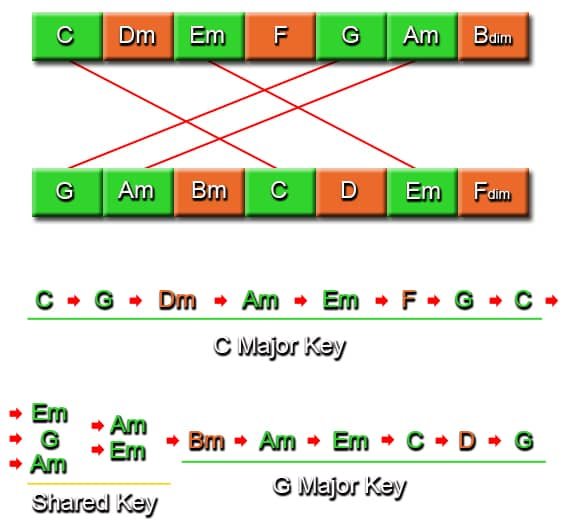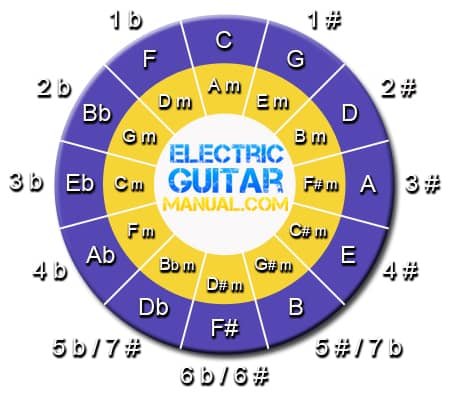
Music Modulation: How to Change Pitch During the Course of a Musical Theme. Modulation to distantly vs closely related keys.
Music Modulation: How to Change Key Within a Song
Modulation consists of the passage from one tonality to another, during the course of a musical theme. This resource is essential to add another air to a piece of music (movement) and avoid monotony, or to enhance or emphasize certain parts of the theme.
The modulations can be closely or distantly (soft or abrupt), depending on the effect we want to achieve.
Modulation to Closely Related Keys
The modulation to closely related keys are the tonality changes that we can make between music scales with great similarity between them.
For example, if we want to go from the key of C Major to the key of A minor, it would be very simple. Since both scales are made up of exactly the same notes. Since A minor would be the relative minor scale of C.
In short, we can go directly from the C major scale to the A minor scale, after finishing a time in the key of C. In this way we would find ourselves in the new key, making a very smooth modulation (Image Below).
This is a very simple example of modulation from C Major to A Minor, done with the same degrees of each scale (1st – 4th – 5th). Drastic modulation but without dissonance, due to the agreement between both scales or keys.
Music Modulation: C Major to A Minor Key Change
For a smoother and more refined transition between keys, we should pause briefly on the last chord before moving on to the new key. Or in other words, it is better not to go from one tonality to another abruptly or quickly.
Taking the chart below as an example, we would have to wait a bit on the C Major chord, before moving on to the A minor chord. Do this and you will see how the transition is practically imperceptible, as that small pause opens between both tonalitys.

In the circle of fifths we can discover those neighboring tonalities, in a very simple way. For example, from the tone of C, we can move on to the five tones that are around it in the circle of fifths (F – G – Dm – Am – Em), with ease and smoothness, without the ear detecting strong sounds.
As you can see, we have many possibilities, and the same goes for any tonality that interests us, both the blue (Major) and the yellow (minor) circle.
Closely Related Keys in the Circle of Fifths

What is the Key to Musical Modulation?
The common chords between two scales or tonalitys would be those that open the door for us to modulate between them, and thus be able to move from one tonality to another.
How to modulate from C to G:
In the first place we have the keys of both tones with their differences and their concordances. We will use the concordances to travel from one key to another, and the differences to consolidate a tonality.
Music Modulation: How to Change Keys

Secondly, we have a sequence of chords (above) with practically all the notes of the two tonalitys, and an example is shown of how to slide from the key of C to the key of G, with a large number of options and with total smoothness.
We can use this system for the rest of the closely related keys of C: F – Dm – Em, and transfer it to any position on the circle of fifths to do the same with other tonalitys.
Music Modulation: Distantly Related Keys
The modulations in distantly related keys are those that we develop between tonalitys with a great difference between the notes of which they are composed.
In the circle of fifths we can see the differences between the different tonalitys.
Flats and Sharps on the Circle of Fifths

How to Change from Major to Minor Key
A distantly modulation would be changing the same key from Major to Minor, for example from A Major to A Minor. One way to modulate from Major to minor would be playing an A Major, and then an A minor, to definitely take this chord as the tonic.
A Major to A Minor Key Change

We can also go from A Major to A minor by the fourth note of the Major scale, but played in minor (Dm).

Or if we prefer we can go from A major to D minor for this same note, for the minor fourth of A Major (Dm).

The very distantly modulations would be the variations of a semitone between two keys, since all the notes would be different between the two tonalitys. But it would be as simple as lowering the entire structure a semitone to obtain a decay effect.

How to Change the Key Within Song to a Higher Key
In order to have a high or push consequence, we would have to raise the key one tone, for example from C to D. The best way to do this, is through the fifth note of the key of C (G), and from there go to the key of D directly. Since G is a note shared between both scales: 5th note of the C scale, and 4th note of the D scale.
C Major to D Major Key Change

